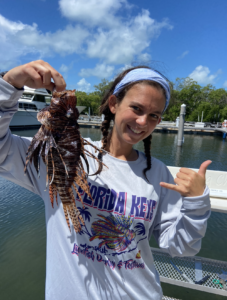As a vegetarian, I never thought I would find myself spearing fish—and enjoying it. But here I was, with a lionfish at the end of my pole spear, the thrill of my first catch still there as I transferred it to a waiting ZooKeeper (lionfish containment device).
Lionfish are invasive to the Tropical Western Atlantic (TWA) region, and not only have they become established; they’re thriving. Originally from the Indo-Pacific, lionfish can now be found in huge numbers all the way up the East Coast of the United States and down to Brazil, in depths from 10 to 1,000 feet. Wherever they are, they’re terrorizing the native ecosystems with their voracious appetite. Lionfish will eat almost any prey species, and anything that will fit in their mouths and stomach (and even sometimes if it can’t). Many times, lionfish are found with fish popping out of their mouths because their prey was too big, or with a burst stomach.
With no native predator here in the TWA, humans have stepped up to control lionfish populations. This is where one of REEF’s main programs, the Invasive Species Program, which focuses on lionfish, comes in. To help fight the invasion, REEF educates the public, hosts lionfish derbies, and is conducting research on deep-water lionfish traps—all of which I’ve been able to get involved with this summer.
Not only have I aided in education through our Ocean Explorers Education Program I talked about in my last blog post, but also through informal tabling at local events and lionfish jewelry workshops. Despite how destructive they are, it’s undeniable that lionfish are beautiful—which makes their fins perfect for making jewelry. Not only does making lionfish jewelry increase lionfish economic value, but it also raises awareness. I’ve worn my lionfish necklace all summer, and it has started so many great conversations about lionfish, and created opportunities to spread more information.
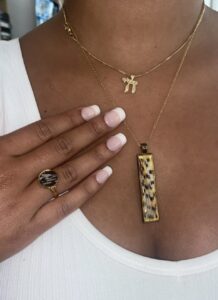
Lionfish necklace and ring, made during a lionfish jewelry workshop
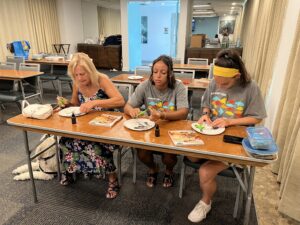
Lionfish jewelry workshop at Amoray Cay Resort
In addition to everyday conversations I’ve had with others, tabling is a great way to spread information beyond people we normally reach during our structured programs. I’ve tabled at an art walk outside the local brewery, and outside a major dive shop during lobster mini-season, creating a major range of people. Here, we’re able to clear up common misconceptions—for example, we explain that lionfish are actually venomous, not poisonous, so they’re safe to eat—or further detail lionfish spearing regulations to those going out lobstering in case they see one.
Through working at REEF, I’ve developed a stronger passion for education after I saw firsthand how if given the knowledge, people want to be involved and help with ocean conservation concerns. Most of the time, they just don’t know how. I wanted to reach a wider audience, which is why I created a social media series this summer on REEF’s Invasive Species Facebook Page. I created an infographic for each Sunday in the month of July, with each week focusing on a different way that people can get involved with lionfish. These included how to catch lionfish, lionfish jewelry and cooking, new developments in lionfish research, and advertising REEF’s upcoming derby. I had a lot of fun with this project, in creating the graphics, and learning to condense and clarify dense, important information. It was also cool to see after they were posted how people interacted and shared the posts.
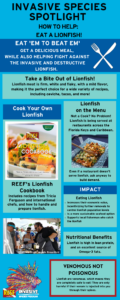
Infographic on Eating Lionfish from my July Invasive Species Social Media series
In addition to education, there’s also the derbies—single-day events where teams compete to remove as many lionfish as possible. Although I unfortunately won’t be here for either of REEF’s two biggest derbies, in April and September, I was lucky enough to be here during for a smaller derby, held in place of the normal April derby where many teams had been unable to compete due to bad weather. Here, I was able to get a small taste of what it was like. After teams came and dropped off their catch, I helped measure them, and fillet them. Derbies, along with regular removals, are one of the most effective methods of controlling lionfish, so it was really cool to be part of that.
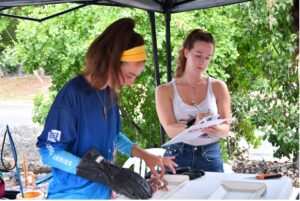
Measuring lionfish: At a derby, prizes are given to those who remove the smallest and largest lionfish
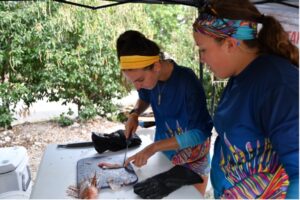
Learning how to fillet a lionfish, to eat later
REEF’s derbies and workshops on how to successfully and carefully remove lionfish have been a huge success, and in partnership with the community, have done wonders in controlling their populations. In the Florida Keys, finding a lionfish on the shallow reefs is a lot less likely, and I only saw a handful all summer. This is not the case in other areas of the Caribbean, where lionfish still run rampant on shallow reefs due to stricter spearing regulations.
But, while we’ve done a great job spearing and netting lionfish in the shallow regions, lionfish are still thriving in deeper waters where SCUBA can’t reach. REEF is currently working on developing a deep-water lionfish trap, known as the Gittings trap. The trap consists of a large metal rebar frame, with netting and a fish aggregating device (FAD) in the middle that attracts the lionfish. REEF is currently in the testing phase of these traps. Our goal is to eventually send them out with local fishermen to increase removal efficiency and provide opportunity for economic gain from the lionfish caught by allowing the fishermen to sell them with their other catch.
This research is what led me to my first spearing experience. That day, I had gone out with a few staff members on a trap retrieval mission. By 7 a.m., we were out on the boat. I’d been prepped for the worst conditions—4–6 foot waves, bad vis—but everything seemed to work out in our favor. The waves weren’t too bad, visibility was decent, and we found the trap quickly. With our main goal complete, we then had plenty of time to spear some lionfish.

Myself and members of REEF’s Conservation Science team with the removed Gittings trap
This was one of one of my first deep dives of the summer, and at 90 feet, there were many more lionfish than I was used to. However, we made quick work of spearing as many as possible, and in two short dives, we were able to remove 28. Although it took me a second to get the hang of the pole spear, I was proud to leave the dive with my first, and second, lionfish speared.
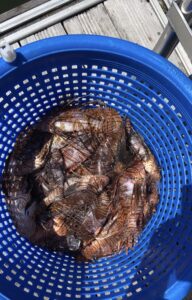
Twenty-eight lionfish speared, which were brought back to the dock to be measured and filleted
Although I’d learned a lot about these traps at work already, and even helped build them, seeing one deployed, how it worked under water, and how it would be removed was a really cool experience. Seeing all the lionfish on the deeper reef also made me realize how important these traps were, and the process of continuing to develop technology to fight the ever-evolving lionfish problem.
Seeing all the different parts of the Invasive Species Program and how they take multiple angles to tackle one main issue has been an interesting experience and has given me a lot to think about as far as ocean conservation. It was really inspiring to see how successful the program is, and to be able to participate in it and contribute to the cause myself. At the end, the major successes of the program are thanks to community and government support, and continued success will rely on it as well, from getting fishers involved, to local restaurants selling lionfish, to everyday people supporting the cause. I’m most thankful to have contributed to raising awareness, to help ensure this community support continues. I’m also hoping to make it down to the Keys to experience a big derby for myself one year!
